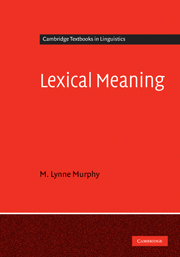Book contents
- Frontmatter
- Contents
- List of figures
- Preface: using this book
- Acknowledgments
- Typographical conventions
- Part I Meaning and the lexicon
- Part II Relations among words and senses
- 5 Meaning variation: polysemy, homonymy, and vagueness
- 6 Lexical and semantic relations
- Part III Word classes and semantic types
- References
- Index
6 - Lexical and semantic relations
from Part II - Relations among words and senses
Published online by Cambridge University Press: 05 June 2012
- Frontmatter
- Contents
- List of figures
- Preface: using this book
- Acknowledgments
- Typographical conventions
- Part I Meaning and the lexicon
- Part II Relations among words and senses
- 5 Meaning variation: polysemy, homonymy, and vagueness
- 6 Lexical and semantic relations
- Part III Word classes and semantic types
- References
- Index
Summary
Key words:
paradigmatic, syntagmatic, semantic relation, lexical relation, synonym, contrast, antonym, complementary, contrary, converse, hyponym, hyperonym, meronym, holonym, dictionary approach, thesaurus approach, semantic field, lexical blocking
Overview
This chapter examines particular semantic relations among words. They are called semantic relations because they are relations between senses. Some cases of semantic relation can also be lexical relations in which it is not just the meanings that are related, but also other aspects of the lexemes, like morphological form or collocational patterns. After looking at the details of synonymy, hyponymy, antonymy, and other relations, we evaluate two approaches to the representation of semantic relations in the mental lexicon. In the first approach, the lexicon is theorized to be like a dictionary, which records senses but not necessarily relations among them. The second views the lexicon like a thesaurus, in which relations, but not meanings, are represented.
- Type
- Chapter
- Information
- Lexical Meaning , pp. 108 - 132Publisher: Cambridge University PressPrint publication year: 2010

